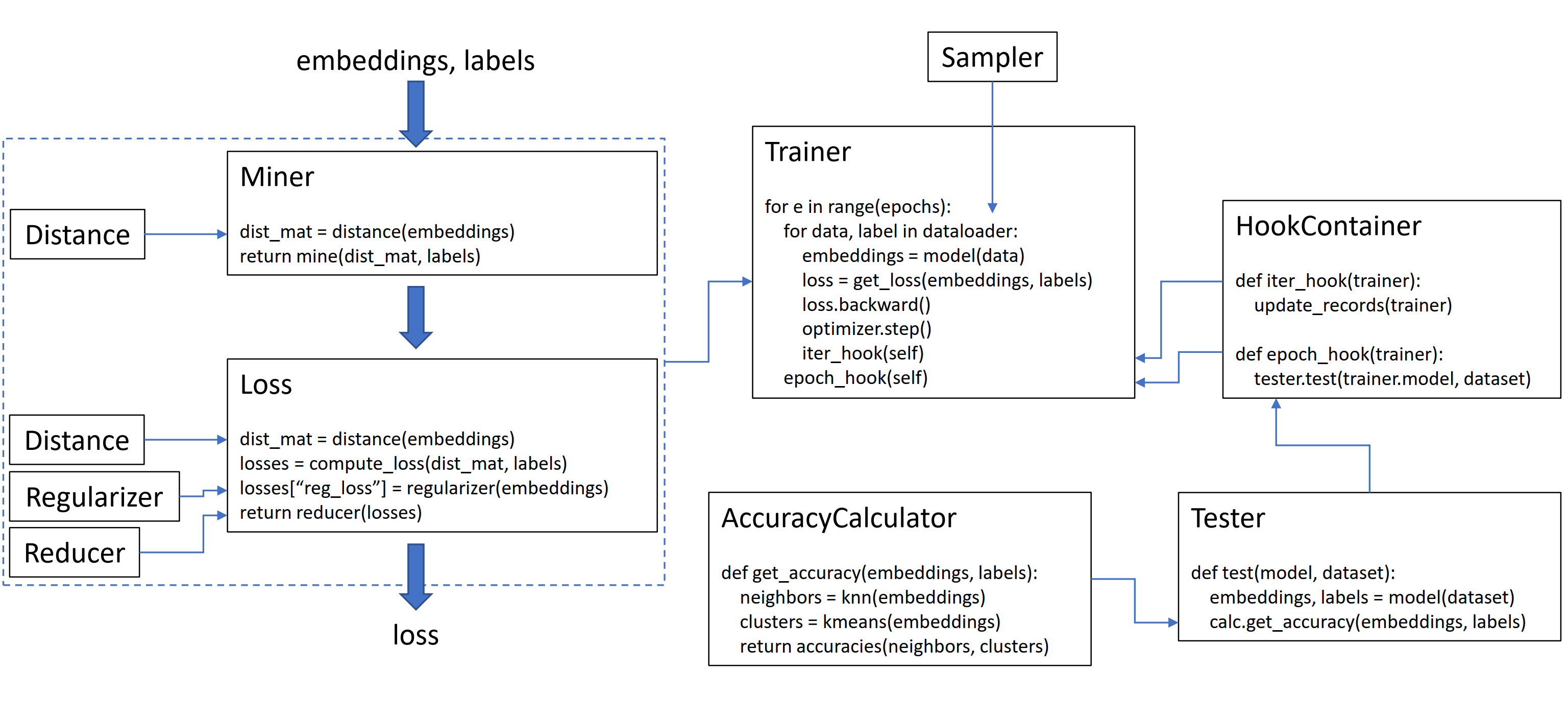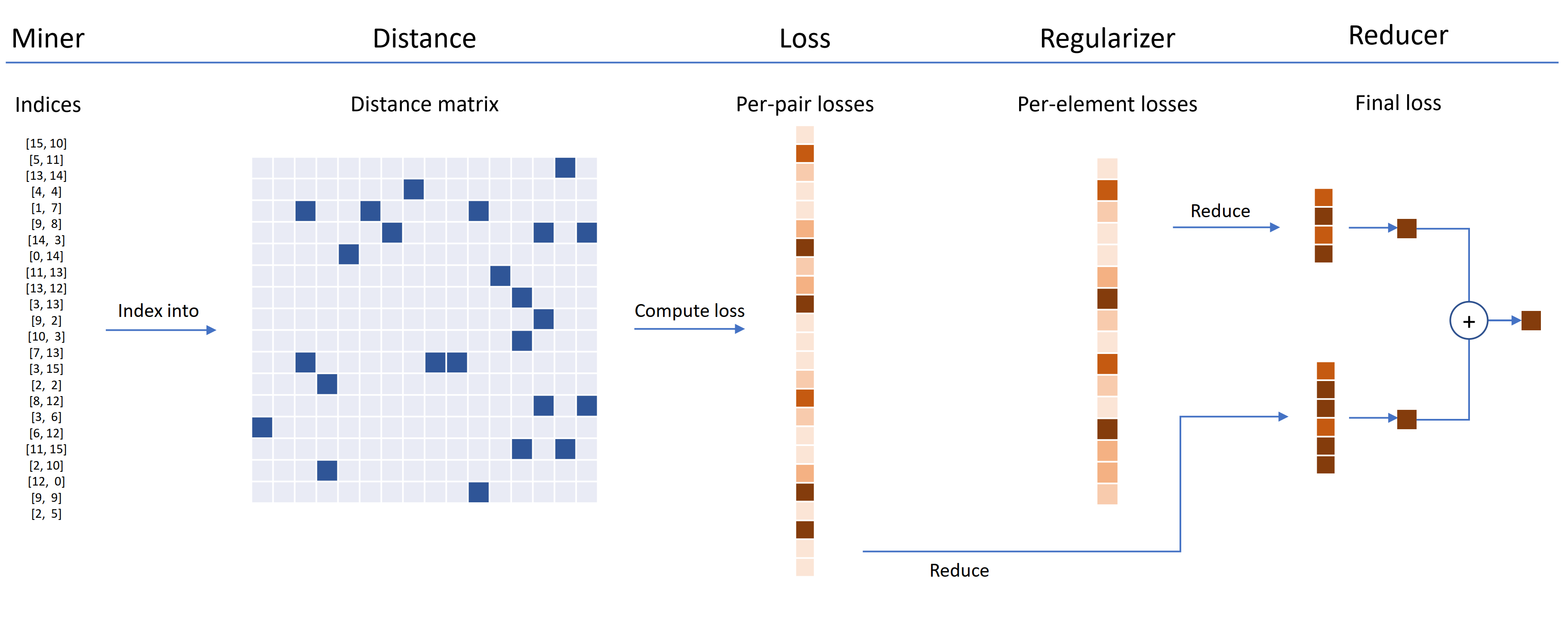March 30: v1.3.0
- Added a
batch_sizeparameter to CustomKNN, and fixed a couple of bugs. See the release notes. - Thanks to contributor cwkeam.
February 28: v1.2.0
- New loss function: SubCenterArcFaceLoss. See the release notes.
- Thanks to contributor chingisooinar.
- View the documentation here
- View the installation instructions here
- View the available losses, miners etc. here
See the examples folder for notebooks you can download or run on Google Colab.
This library contains 9 modules, each of which can be used independently within your existing codebase, or combined together for a complete train/test workflow.
Let’s initialize a plain TripletMarginLoss:
from pytorch_metric_learning import losses
loss_func = losses.TripletMarginLoss()To compute the loss in your training loop, pass in the embeddings computed by your model, and the corresponding labels. The embeddings should have size (N, embedding_size), and the labels should have size (N), where N is the batch size.
# your training loop
for i, (data, labels) in enumerate(dataloader):
optimizer.zero_grad()
embeddings = model(data)
loss = loss_func(embeddings, labels)
loss.backward()
optimizer.step()The TripletMarginLoss computes all possible triplets within the batch, based on the labels you pass into it. Anchor-positive pairs are formed by embeddings that share the same label, and anchor-negative pairs are formed by embeddings that have different labels.
Sometimes it can help to add a mining function:
from pytorch_metric_learning import miners, losses
miner = miners.MultiSimilarityMiner()
loss_func = losses.TripletMarginLoss()
# your training loop
for i, (data, labels) in enumerate(dataloader):
optimizer.zero_grad()
embeddings = model(data)
hard_pairs = miner(embeddings, labels)
loss = loss_func(embeddings, labels, hard_pairs)
loss.backward()
optimizer.step()In the above code, the miner finds positive and negative pairs that it thinks are particularly difficult. Note that even though the TripletMarginLoss operates on triplets, it’s still possible to pass in pairs. This is because the library automatically converts pairs to triplets and triplets to pairs, when necessary.
Loss functions can be customized using distances, reducers, and regularizers. In the diagram below, a miner finds the indices of hard pairs within a batch. These are used to index into the distance matrix, computed by the distance object. For this diagram, the loss function is pair-based, so it computes a loss per pair. In addition, a regularizer has been supplied, so a regularization loss is computed for each embedding in the batch. The per-pair and per-element losses are passed to the reducer, which (in this diagram) only keeps losses with a high value. The averages are computed for the high-valued pair and element losses, and are then added together to obtain the final loss.
Now here's an example of a customized TripletMarginLoss:
from pytorch_metric_learning.distances import CosineSimilarity
from pytorch_metric_learning.reducers import ThresholdReducer
from pytorch_metric_learning.regularizers import LpRegularizer
from pytorch_metric_learning import losses
loss_func = losses.TripletMarginLoss(distance = CosineSimilarity(),
reducer = ThresholdReducer(high=0.3),
embedding_regularizer = LpRegularizer())This customized triplet loss has the following properties:
- The loss will be computed using cosine similarity instead of Euclidean distance.
- All triplet losses that are higher than 0.3 will be discarded.
- The embeddings will be L2 regularized.
The TripletMarginLoss is an embedding-based or tuple-based loss. This means that internally, there is no real notion of "classes". Tuples (pairs or triplets) are formed at each iteration, based on the labels it receives. The labels don't have to represent classes. They simply need to indicate the positive and negative relationships between the embeddings. Thus, it is easy to use these loss functions for unsupervised or self-supervised learning.
For example, the code below is a simplified version of the augmentation strategy commonly used in self-supervision. The dataset does not come with any labels. Instead, the labels are created in the training loop, solely to indicate which embeddings are positive pairs.
# your training for-loop
for i, data in enumerate(dataloader):
optimizer.zero_grad()
embeddings = your_model(data)
augmented = your_model(your_augmentation(data))
labels = torch.arange(embeddings.size(0))
embeddings = torch.cat([embeddings, augmented], dim=0)
labels = torch.cat([labels, labels], dim=0)
loss = loss_func(embeddings, labels)
loss.backward()
optimizer.step()If you're interested in MoCo-style self-supervision, take a look at the MoCo on CIFAR10 notebook. It uses CrossBatchMemory to implement the momentum encoder queue, which means you can use any tuple loss, and any tuple miner to extract hard samples from the queue.
- For a convenient way to train your model, take a look at the trainers.
- Want to test your model's accuracy on a dataset? Try the testers.
- To compute the accuracy of an embedding space directly, use AccuracyCalculator.
If you're short of time and want a complete train/test workflow, check out the example Google Colab notebooks.
To learn more about all of the above, see the documentation.
pytorch-metric-learning >= v0.9.90requirestorch >= 1.6pytorch-metric-learning < v0.9.90doesn't have a version requirement, but was tested withtorch >= 1.2
Other dependencies: numpy, scikit-learn, tqdm, torchvision
pip install pytorch-metric-learning
Other installation options
To get the latest dev version:
pip install pytorch-metric-learning --pre
To install on Windows:
pip install torch===1.6.0 torchvision===0.7.0 -f https://download.pytorch.org/whl/torch_stable.html
pip install pytorch-metric-learning
To install with evaluation and logging capabilities
(This will install the unofficial pypi version of faiss-gpu, plus record-keeper and tensorboard):
pip install pytorch-metric-learning[with-hooks]
To install with evaluation and logging capabilities (CPU)
(This will install the unofficial pypi version of faiss-cpu, plus record-keeper and tensorboard):
pip install pytorch-metric-learning[with-hooks-cpu]
conda install pytorch-metric-learning -c metric-learning -c pytorch
To use the testing module, you'll need faiss, which can be installed via conda as well. See the installation instructions for faiss.
See powerful-benchmarker to view benchmark results and to use the benchmarking tool.
Development is done on the dev branch:
git checkout dev
Unit tests can be run with the default unittest library:
python -m unittest discoverYou can specify the test datatypes and test device as environment variables. For example, to test using float32 and float64 on the CPU:
TEST_DTYPES=float32,float64 TEST_DEVICE=cpu python -m unittest discoverTo run a single test file instead of the entire test suite, specify the file name:
python -m unittest tests/losses/test_angular_loss.pyCode is formatted using black and isort:
pip install black isort
./format_code.shThanks to the contributors who made pull requests!
| Contributor | Highlights |
|---|---|
| cwkeam | - CentroidTripletLoss - VICRegLoss - Added mean reciprocal rank accuracy to AccuracyCalculator |
| mlopezantequera | - Made the testers work on any combination of query and reference sets - Made AccuracyCalculator work with arbitrary label comparisons |
| marijnl | - BatchEasyHardMiner - TwoStreamMetricLoss - GlobalTwoStreamEmbeddingSpaceTester - Example using trainers.TwoStreamMetricLoss |
| chingisooinar | SubCenterArcFaceLoss |
| elias-ramzi | HierarchicalSampler |
| fjsj | SupConLoss |
| AlenUbuntu | CircleLoss |
| wconnell | Learning a scRNAseq Metric Embedding |
| AlexSchuy | optimized utils.loss_and_miner_utils.get_random_triplet_indices |
| JohnGiorgi | all_gather in utils.distributed |
| Hummer12007 | utils.key_checker |
| vltanh | Made InferenceModel.train_indexer accept datasets |
| btseytlin | get_nearest_neighbors in InferenceModel |
| mlw214 | Added return_per_class to AccuracyCalculator |
| z1w | |
| thinline72 | |
| tpanum | |
| fralik | |
| joaqo | |
| JoOkuma | |
| gkouros | |
| yutanakamura-tky | |
| KinglittleQ |
Thank you to Ser-Nam Lim at Facebook AI, and my research advisor, Professor Serge Belongie. This project began during my internship at Facebook AI where I received valuable feedback from Ser-Nam, and his team of computer vision and machine learning engineers and research scientists. In particular, thanks to Ashish Shah and Austin Reiter for reviewing my code during its early stages of development.
This library contains code that has been adapted and modified from the following great open-source repos:
- https://github.com/bnu-wangxun/Deep_Metric
- https://github.com/chaoyuaw/incubator-mxnet/blob/master/example/gluon/embedding_learning
- https://github.com/facebookresearch/deepcluster
- https://github.com/geonm/proxy-anchor-loss
- https://github.com/idstcv/SoftTriple
- https://github.com/kunhe/FastAP-metric-learning
- https://github.com/ronekko/deep_metric_learning
- https://github.com/tjddus9597/Proxy-Anchor-CVPR2020
- http://kaizhao.net/regularface
Thanks to Jeff Musgrave for designing the logo.
If you'd like to cite pytorch-metric-learning in your paper, you can use this bibtex:
@misc{musgrave2020pytorch,
title={PyTorch Metric Learning},
author={Kevin Musgrave and Serge Belongie and Ser-Nam Lim},
year={2020},
eprint={2008.09164},
archivePrefix={arXiv},
primaryClass={cs.CV}
}


